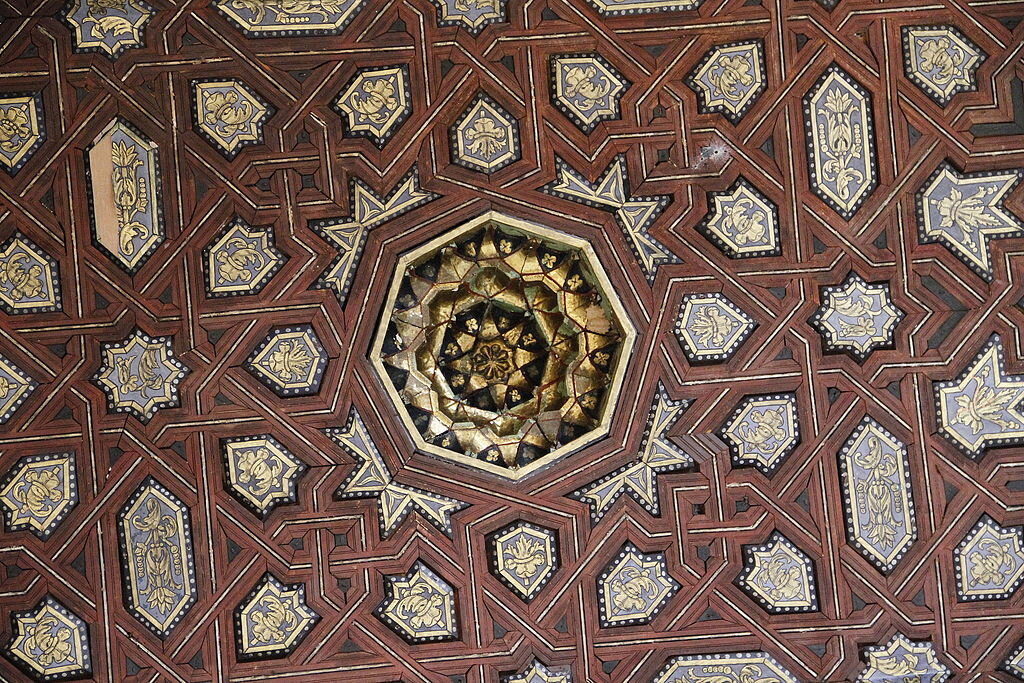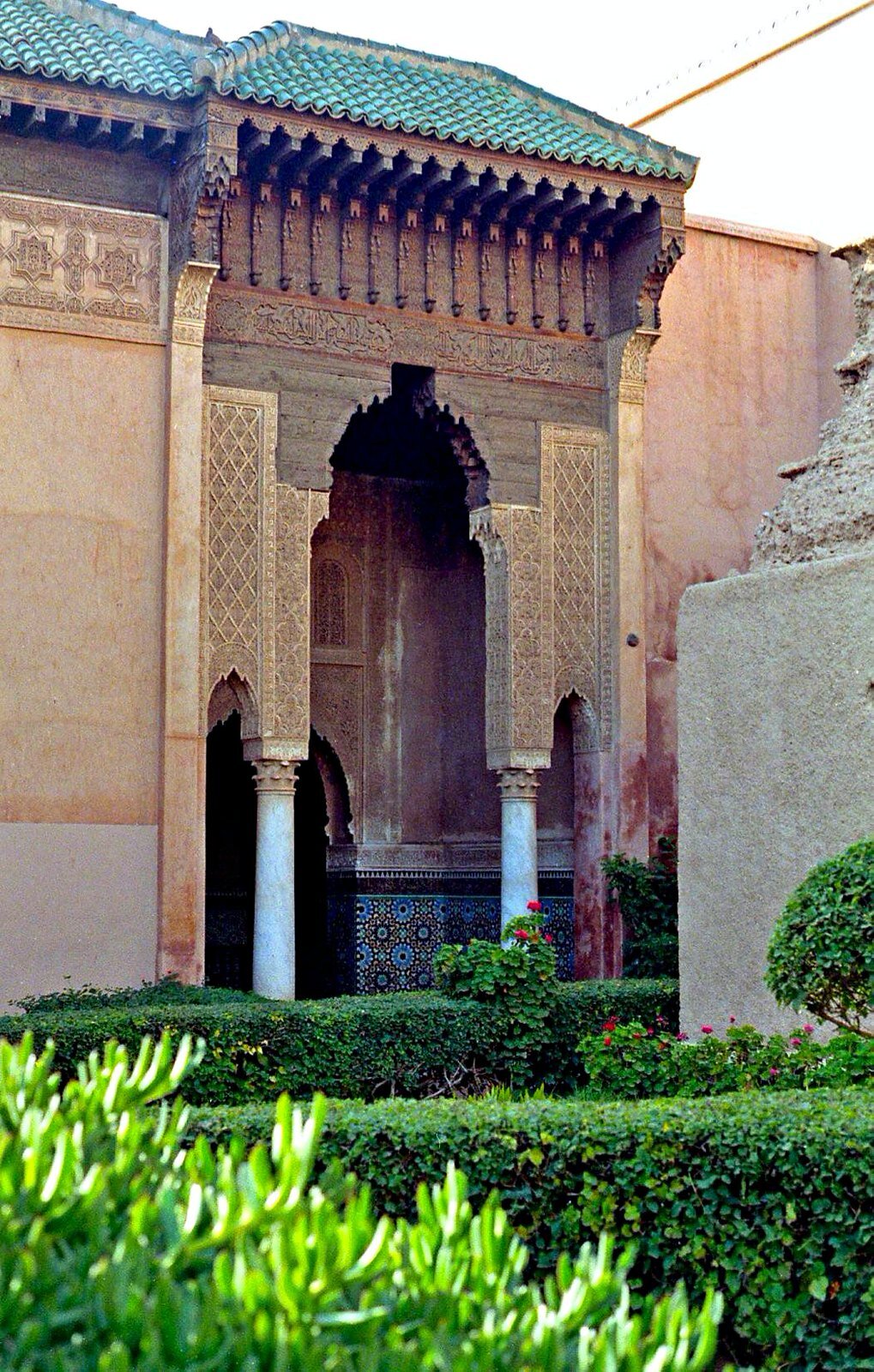Peek inside the royal necropolis in Marrakech, which rivals parts of the Alhambra in its beauty. We can thank Sultan al-Mansur for its magnificence — and Ismail Ibn Sharif’s fear of the dead for leaving it intact.
The Saadian Tombs in 1925
Don’t judge a tomb by its cover. The unremarkable exterior walls surrounding the Saadian Tombs in the medina of Marrakech concealed their exquisite mausoleums for centuries, attracting little more than stray cats and storks. While not much to look at from the outside, the secluded interior courtyard is a completely different matter.
Walled in and forgotten for more than two centuries, the necropolis of the deceased Saadian royals and their descendants remained hidden until its discovery in 1917. French Resident-General Hubert Lyautey commissioned an aerial survey of Marrakech and, by chance, the photographs revealed the existence of the tombs. They were brought back from disrepair by the Service des Beaux-Arts, Antiquités et des Monuments Historiques before being opened to the general public.
The unassuming exterior of the Saadian Tombs belies its gorgeous interior.
The historic property is located along the Rue de la Kasbah near the ruins of the El Badi Palace. Even if you have a strong sense of direction, the unmarked streets and nondescript ancient rammed earth walls surrounding many of the buildings in the medina district of Marrakech make finding a destination challenging.
Ahmad al-Mansur
We eventually did and purchased our tickets, which cost 70 dirhams, or around $8, each. Wally, our friend Vanessa and I passed through an inconspicuous narrow corridor cut into the exterior wall and emerged into a tranquil courtyard garden.
The royal necropolis dates back to the beginning of the 14th century and originally served as a courtyard garden of the Kasbah Mosque. It wasn’t until the reign of the sixth and most famous sultan of the Saadian dynasty, Ahmad al-Mansur (who reigned from 1578-1603 and was known as Eddahbi, the Golden), that the construction of the tombs reached a far more elegant and refined status. Before al-Mansur died from the plague in 1603, he expanded and embellished its mausoleums in the grand style of the Alhambra, the royal residence of the Nasrid Kingdom, built 200 years prior in Granada, Spain.
Brightly tiled tombstones fill the courtyard.
A Rested Development
Seven sultans and 62 family members are interred in the Saadian Tombs, with over 100 more outside in the gardens.
The courtyard enclosure includes two mausoleums with gabled, glazed green roof tiles of kiln-fired clay.
The gravestones in the mihrab, or prayer niche, reminded us of prayer mats.
The main tombs are located to the left of the enclosure. The first of the three chambers was originally a mihrab, or prayer niche, and is now the final resting place of Saadian princes. Its walls and floors are covered with intricate multicolored zellij mosaic tiles. The varying shapes, colors and patterns embedded in the flat graves reminded me of prayer rugs, laid facing Mecca, for eternity. The stucco work of the archway is delicate and ornate, while the ceiling is equally impressive.
The Hall of Twelve Columns is the star of the show.
Pillars of Society: The Hall of Twelve Columns
The central mausoleum where al-Mansour lies is known as the Hall of Twelve Columns. This chamber incorporates a dozen Carrera marble pillars, carved stucco walls and gilt honeycomb ceiling vaulting known as muqarnas. Al-Mansur traded sugar with the Italians in exchange for the marble, which is fitting, as its white, crystalline surface resembles the fine granular texture of sugar. The sultan’s narrow marble headstone stands in the center of the room and is flanked by those of his son and grandson. The chamber is also home to the remains of Princess Zahra, whose epitaph reads, “Here is the tomb of the noble lady, new moon, marvel of virtues.”
A coffered cedarwood ceiling with sunken square panels of diminishing sizes representing the earth and a circle at its apex standing in for the heavens spans the columned central chamber. This sacred geometry symbolizes the passage from the material to the spiritual world.
Recent restoration work on the Saadian Tombs began in 2013 and lasted for two years.
The Three Niche Chamber and Lalla Masuda Qubba
Beyond the great hall is the Three Niche Chamber, where those relations deemed less important, including children, are buried. The three arched recesses for which the mausoleum takes its name feature magnificent incised muqarnas embossed in gold, lending the space a luminous quality.
The “less important” relatives were interred in the Three Niche Chamber, which is still not too shabby a place to spend eternity, if you ask us.
Between the mausoleums and throughout the gardens are descendants, wives and emirs, each resting closer or further away from al-Mansur’s sepulcher, depending on his or her status.
The entrance to the Lalla Masuda Qubba. As with the rest of the complex, you can’t go inside — but you can peek into the chambers.
The second and smaller structure is called the Lalla Masuda Qubba and refers to the domed roof mausoleum which contains the grave of al-Mansur’s mother.
Lalla Masuda
The oldest and original Saadian tomb includes a cedarwood dome and two entrance porches or loggias. It was built by Sultan Abdallah al-Ghalib to bury his father, Mohammed al-Sheikh, the founder of the dynasty.
In 1591, al-Mansur had his mother, Lalla Masuda, added to the tomb. She was a Moroccan political figure in the Saadi dynasty remembered for her humanitarian work and considered an awliya, or saint.
Fearing the Dead
Less than two decades later, Sultan Ahmad al-Abbas was assassinated, the Saadian dynasty had come to an end, and the Alaouites had taken control of the country.
When Sultan Moulay Ismail Ibn Sharif assumed power, he wasted no time eradicating the legacy of the Saadi dynasty. He systematically set about looting and stripping most of their architectural achievements, including the El Badi Palace. However, he spared the Saadian Tombs — probably because he feared bad luck if he desecrated them and was superstitious that the spirits of the dead would pursue him. He satisfied himself with sealing up all but one obscure entrance from the Kasbah Mosque.
Moulay Ismail Ibn Sharif completely stripped the nearby El Badi Palace but left the Saadian Tombs intact. Was he nervous about disturbing the spirits of the dead?
The Saadian Tombs gave us a sense of the former grandeur of the El Badi Palace. Heads up that the various chambers are off limits to the public, but a path winds past them, letting tourists see them from outside, much like peeking into a diorama.
While the tombs are cordoned off to human visitors, felines are another matter. We witnessed more than a few cats and kittens napping on their cool tiled floors.
If you enjoy Islamic architecture as much as we do, then a visit to this funerary monument and tribute to the Saadian legacy is a must. –Duke



































